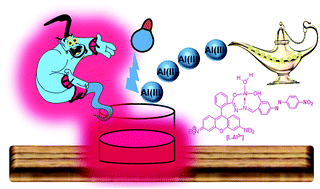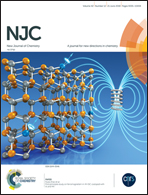A novel chemosensor based on rhodamine and azobenzene moieties for selective detection of Al3+ ions†
Abstract
The high absorption coefficient, fluorescence quantum yield, photo stability and relatively long wavelengths of rhodamine dye have expanded its applicability as a promising fluorescent probe. In the present investigation, two dyes, namely rhodamine and azobenzene, have been conjugated for the detection of Al3+ in aqueous ethanol. The turn on fluorescence response of chemosensor L towards Al3+ is attributed to the inhibited PET (photo-induced electron transfer) and CHEF (chelation enhanced fluorescence) process along with the spirolactam (non-fluorescent) to ring-opened amide (fluorescent) process. The presence of the PET and CHEF process was corroborated by time-resolved photoluminescence study and the spirolactam ring opening was confirmed by 13C NMR and infrared spectroscopy. In the presence of Al3+, the opened spirolactam ring forms a 1 : 1 binding complex with the metal, which is supported by its high binding constant (Ka = 7.033 × 103 M−1). The limit of detection (LOD) and limit of quantification (LOQ) values are found to be 1.1 × 10−7 M and 3.6 × 10−7 M, respectively. The reversible recognition of Al3+ was also proved in the presence of Na2EDTA by both UV-Vis and fluorometric titration. The sensing behaviour of the chemosensor towards Al3+ was supported by DFT/TDDFT calculations.



 Please wait while we load your content...
Please wait while we load your content...